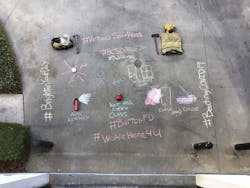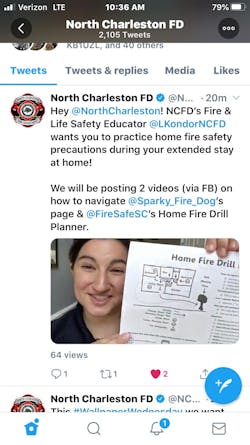COVID-19: A Time for CRR Efforts to Shine
The spread of COVID-19 provides an opportunity for your fire department's community risk reduction outreach to step up and shine, placing the department as a lead agency in addressing this national crisis and doing so right in the homes and at the kitchen tables of every home in your community. Not only does this fulfill the fire department’s purpose of protecting the health and safety of its citizens, it also stresses the non-emergency importance and value that the fire department has in everyone's daily lives.
The national effort to combat COVID-19 fits perfectly into even the most basic departmental CRR outreach efforts - prevention! Everything from proper hand washing and social distancing to the signs and symptoms of the virus, along with the steps to take if you're symptomatic, are exactly what CRR is all about. Fire departments should be taking every opportunity to keep their public informed and educated about COVID-19, and thus empowered, on what to do to prevent its spread and to protect their families and community.
However, there are other very important elements to this national crisis that a fire department’s CRR outreach can address that go beyond the surface of prevention education. These elements go to the very heart of addressing this crisis at a level even more important and valuable than the tangible actions to take, but the equally important intangible needs of our community – calm and security.
This pandemic has struck fear into just about every home in America. Anxiety and concern about COVID-19 affects everyone. This anxiety largely comes from the uncertainty of being in a nationally unprecedented event, which has also led to the disruption of daily lives and familiar-comforting routines. Citizens need to feel a sense of normalcy and routine to calm the fears and anxiety that lead to panic and irrational decisions; these are the underlying currents of social unrest.
Just as passengers on an airplane in extreme turbulence will look to the flight attendants for a calm demeanor, our citizens will look to their local government, i.e. the fire department, for that same sense of “It’s going to be ok.” So beyond the surface of relaying COVID-19 prevention and statistical information to the community, we must also ensure our “passengers” see the calm flight attendants who confidently have everything in control and not see the white knuckles and closed eyes that indicate things are out of control and that the ending is uncertain.
Community risk reduction programs should also seek to address anxieties and fears by providing that sense of calm and normalcy which instills confidence that life is ongoing and will continue, and that while this virus has caused disruptions in daily routines (turbulence), we will continue to fly and eventually land safely.
Be the counterbalance
If your department is the sole source of public safety announcements and information on COVID-19, then that is our first and most important responsibility and should be a priority. However, if other agencies are relaying important, timely and accurate information, then seek to be the counterbalance. Emphasize new safety policies, such as washing hands and social distancing, in a manner that also relays that sense of security and normalcy people seek. Relay positive stories that demonstrate how life and routines continue even with the safety policies in place.
Continuous and repetitive news concerning the impact of COVID-19 on our society, while initially needed, can become stressful when people are constantly immersed in the gloom and doom of the negative side, which is also not productive or healthy. Be the counterbalance people seek. Be the calm flight attendant who is securely and properly seat-belted, and reassure passengers that while the ride maybe rough, taking precautions will ensure a safe landing is in their future.
Be involved
Many organizations, including school systems, are searching for safe ways to maintain contact and interaction with their students, families and communities. Find ways that you can be involved or even facilitate their efforts. For example, many schools have teachers reading books from their homes and posting them on the school’s social media for their students, and other community organizations are leading various virtual community engagement efforts as well. Find ways to participate in their virtual programs and messages or look to create your own virtual outreach. While COVID-19 is a topic, let’s remind our communities that fires, motor vehicle collisions, drownings and other everyday risks are still present in their lives and must be addressed and prioritized.
Be visible
Keeping firefighters healthy through universal precautions and minimizing exposure is a priority. The bottom line is that if we do not have healthy firefighters to respond to emergencies then our problem grows exponentially. However, balance should be considered. While traditional CRR events, where firefighters greet the public and hoist young children into the cabs of the fire trucks, are not safe or appropriate at this time, keeping fire crews visible should still be considered.
Nothing instills calm, security and normalcy like a fire truck. Throughout many communities there are events still taking place such as food distribution sites, drive-thru COVID-19 testing sites, even the local grocery store where people go for supplies. Directly meeting and contacting the public is not appropriate, but parking an apparatus at a distance for firefighters to wave and give a thumbs up to anxious families can go a long way in displaying the type of community togetherness that is needed to instill that routine, calmness and normalcy that people who might be feeling isolated and alone need.
Fire departments will respond to 911 calls and help treat those infected with or suspected of having COVID-19, and that is an important community surface element that we are responsible for. But just below that surface are those other elements that are just as important and possibly even more dangerous, which could lead to social instability and unrest, and broad increases in a wide spectrum of community risks.
Our very presence, either virtually or physically, and our professional approach to our service addresses those underlining currents, and calms those turbulent waters with a sense of normalcy and routine. Our communities depend on us not only for emergency responses and important information, but also to be their steady hand and reassurance that all is stable and in control. It is in our addressing both the surface issues and the underlining elements that the true value of your fire department, and your community risk reduction program, is proven.
Be their calm in this storm.

Daniel Byrne
DANIEL BYRNE is a community support officer for the Burton Fire District, Beaufort County, SC, and a retired assistant fire chief of training for the Georgia Air National Guard 165th Fire Department. A third-generation firefighter, he holds an associate degree and a bachelor’s degree in fire science as well as a master’s degree in public administration and disaster management. Byrne is an alumnus of the National Fire Academy. He received state and local awards for public relations and educational programs as well as community partnerships and served as a conference presenter and keynote speaker.








